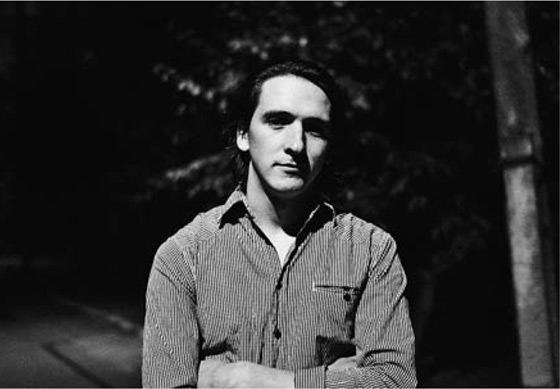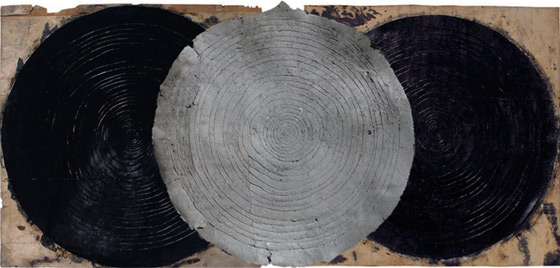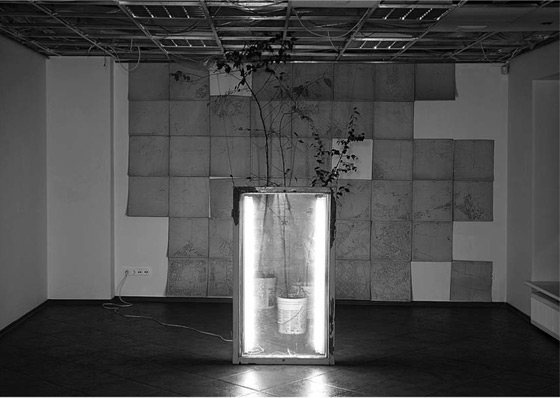|
|
| Raitis Hrolovičs Santa Mičule, Art Academy of Latvia | |
| Considering the younger generation artists who have become part of the exhibition scene over the past few years, Raitis Hrolovičs (born in 1988) seems to be one of the most original and promising. Although young, he has already produced a notable creative output. Hrolovičs studies painting at the Art Academy of Latvia and so far has had two solo shows: one under the title “*” at the gallery L and Jelgava Culture House (2011), and the other named no polish at the Office Gallery of the Contemporary Art Centre (2013). Both solo shows were created as object installations. Hrolovičs’ paintings, on the other hand, have mostly been presented in various group exhibitions by young Latvian and Baltic region painters, and also at the Young Painter Prize exhibition-competition in Vilnius (2012). | |
 Raitis Hrolovičs. 2013 Photo from the private archive of Raitis Hrolovičs | |
| One of the appealing features of Raitis Hrolovičs’ creative activity is a mature and innovative view of painting as a medium at an age when the post-medium state, as declared by the American art theorist and critic Rosalind Krauss1 and characterized by a denial of the intrinsic value of traditional art media, has not yet lost its topicality. Hrolovičs seeks to broaden the variety of materials used for painting, using in the creation of his works non-traditional materials and techniques, for example, industrial materials such as asphalt board or bitumen, and employs the effect of natural forces, e.g. rain to blur an Indian ink painting. His experiments with technical innovations, however, are not only aimed at creating formally new or unusual effects, rather it is a way of getting closer to a natural and completely unprejudiced state of creation without artificiality, turning the very process of painting and the enjoyment it gives into one of the main agents of shaping the idea of the piece of art. The various kinds of interplay between the materials and techniques endow Raitis Hrolovičs’ works with a pronounced physicality, and also equate the material world with that of the painting. In other words, the artist looks for imaginatively expressive meeting points between life and art, and intuitively finds them. This kind of artistic language which is close to physical reality and saturated with tactile expression reflects almost imperceptible metaphysical overtones, creating a welcome contrast to the emphatic simplicity and at times even roughness of the external composition of his paintings. Notwithstanding the vital visual expressivity of his works, Raitis Hrolovičs emphasizes that his art is deeply personal and is based on an introspective symbolism, which makes it next to impossible for most of the audience to grasp its deeper meaning. It is clear that the initial artistic impulses and the results of their implementation may tend to be completely different, and for that reason the aesthetic enjoyment of the works does not depend on knowledge of the so-called ‘artist’s code’ or the intended message. Even though Hrolovičs’ works at their initial stage are aesthetic reflections on private experience, a fact not immediately obvious, of vital importance are the creative mechanisms which help the personal (serving as raw material) to be turned into an artistic phenomenon. Among such agents are abstracted images from nature (e.g. age rings on trees, in more recent pictures), which provoke associations with post-war German neo-romantic traditions and their influence in turning to nature as the closest form of reality to human consciousness (e. g. the radical eco events of Joseph Beuys or the iconography of Anselm Kiefer’s symbolic landscapes, etc.). The abstraction of nature motifs is realized as the formation of imprints, and thisstrategy is modified in various forms and dimensions in order to incorporate physical reality in the compositions. At the basis of the so-called imprint concept is an observation that the visual image of a physical object involves its reflection which, in essence, is the negative of the image. Many of Hrolovičs’ works are in a way attempts to catch the inverse of things that exists to an equal extent as the so-called ‘positive’ or primary image. Believing that the ideal, in both aesthetic and ethical sense, exists within the zone of confluence of the positive and the negative, attempts to depict it become a significant conceptual motivating force. | |
 Raitis Hrolovičs. Being together. Wood, asphalt board, papier mache. 150x350 cm. 2013 Publicity photo Courtesy of the artist | |
| One should highlight Raitis Hrolovičs’ ability to push out the commonly accepted borders of painting without losing its painterly quality, for example, he includes in his compositions such elements as figures and inscriptions, or creates works from connected sheets of paper. At the plein air exhibition Place and Relocation (Kaņepes Culture Centre, 2013) he presented a poetically visualized painting which in the most direct sense of the word grew out of the palette or the paint box (AN-515). His installations also are characterized by an original and imaginative language of expression which is both direct and poetic. It could be said that his success lies in the precise proportions between the metaphorical and the conceptually laconic forms of expression, and in naming the search for these proportions one is inclined to use a poetic description – intuitive alchemy. The creation and exposition of his spatial objects discloses his ability for subtle observation, and a talent to spot artistic potential in objects of nature, industrial setting or any other environment. (His surprising artistic vision occasionally evokes associations with the 1990s installations of Andris Breže). In the exhibition “*” Raitis Hrolovičs turned to the contemplation of the symbiosis of artificial and natural environment, creating an original interpretation of the landscape genre in the form of spatial objects. Making use of both ready-made and self-created objects, landscape was interpreted as a subtle interplay of the elements and fragments of an urbanized environment. This approach is also at the same time an ironic commentary on the relationship of the present-day individual and the environment, where a panoramically broad perception of the world has been substituted by a detached, decontextualized language of signs. The objects exhibited in the installation could be perceived as imprints of an urban lifestyle, bearing obvious signs of human activity, but the actual presence of the human was substituted by the slightly sad stories of the objects. By integrating common artefacts of the surrounding environment into artistic situations, Hrolovičs’ installations reiterate the same principles as those in his paintings – he activates those elements in his audience’s consciousness where the perception of things and occurrences based on emotional and sensual experience dominates over the rational. Instead of depiction, he offers a direct sense of presence, making authenticity the main feature of his art. | |
 Raitis Hrolovičs. ”*”. Installation. Fragment. 2011 Publicity photo Courtesy of the artist | |
| Raitis Hrolovičs’ art is dominated by a masculine dynamism, free from any kind of affectation and convention of depiction. The artist is only at the beginning of his creative career, and I would recommend following his further progress in artistic expression, anticipating even more impressive transgressions of boundaries and regulations which at times become apparent only when we try to verbalize the feelings Hrolovičs’ works provoke. Translator into English: Linda Straume (1) Krauss, Rosalind. A Voyage on the North Sea: Art in the Age of the Post-Medium Condition. London: Thames & Hudson, 1999. | |
| go back | |







